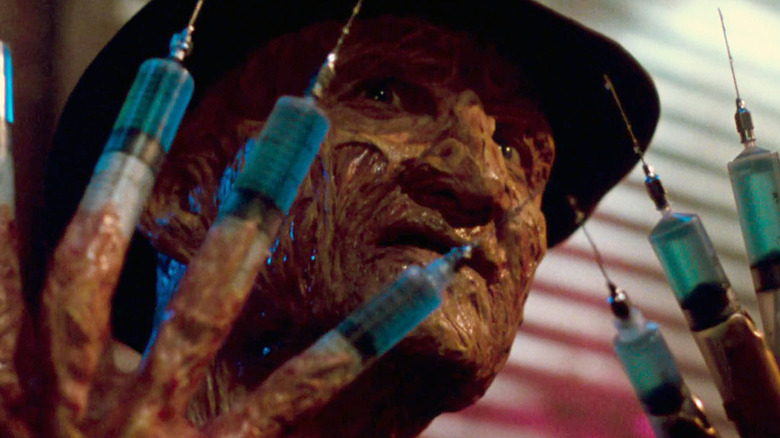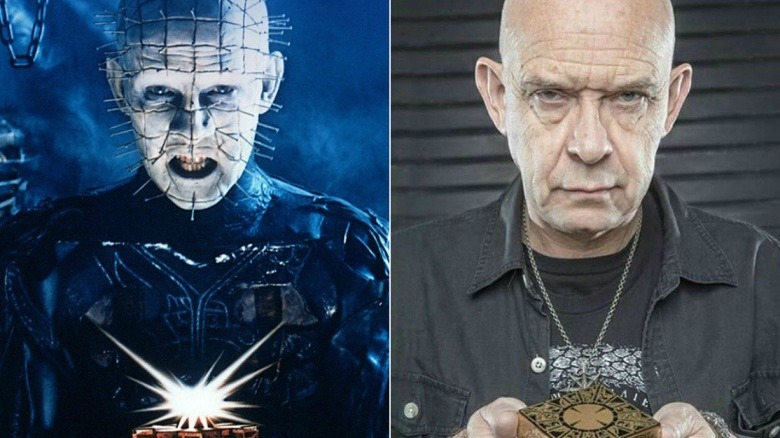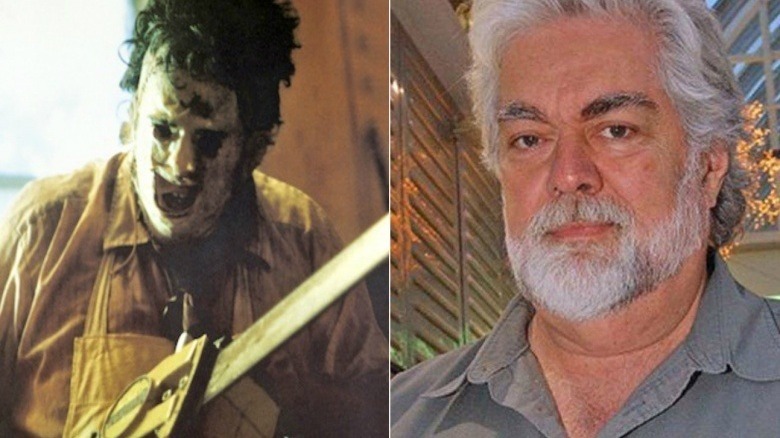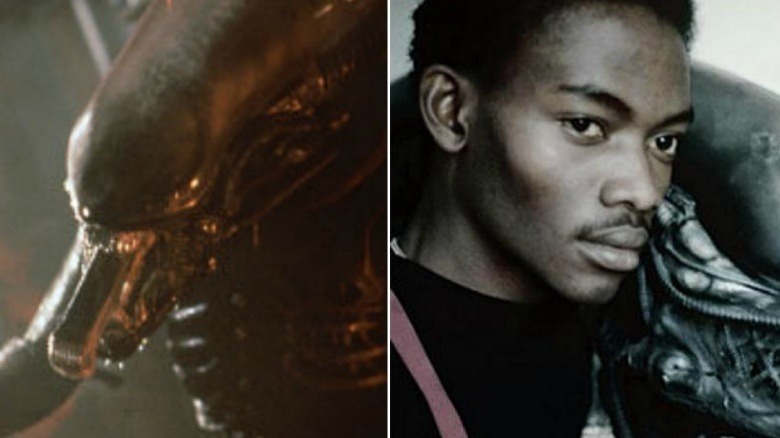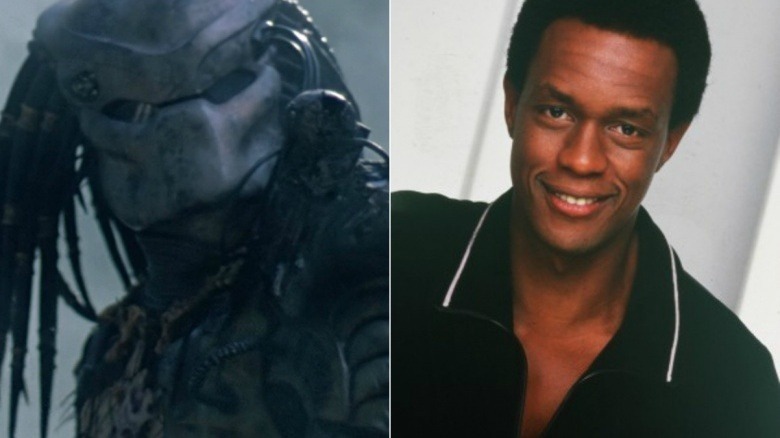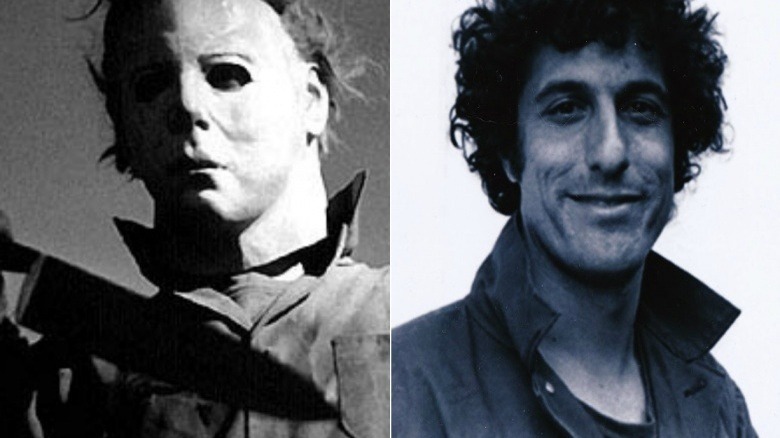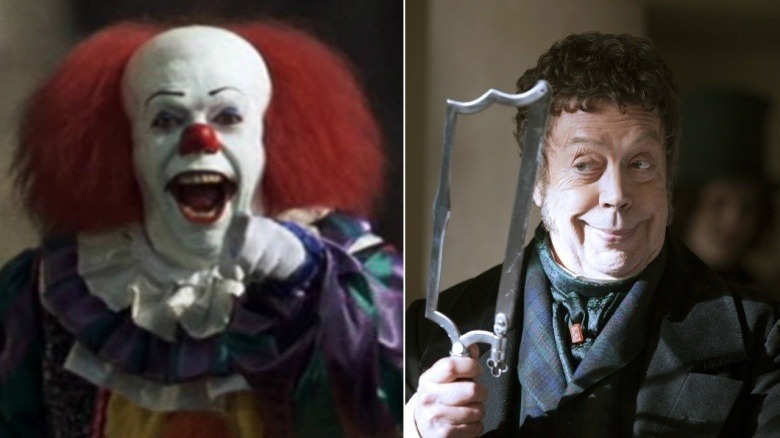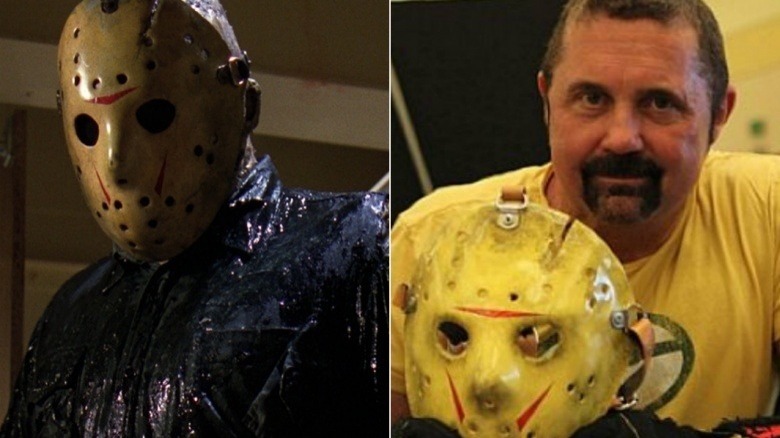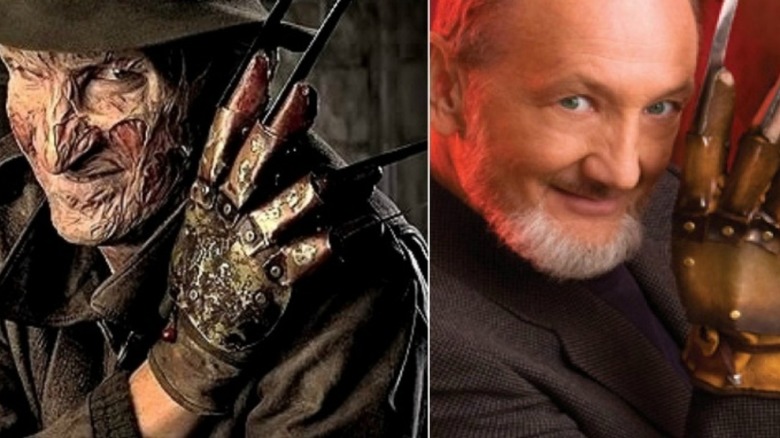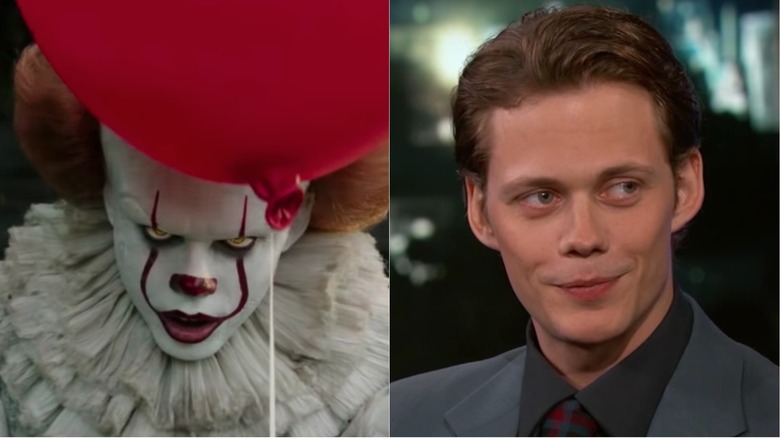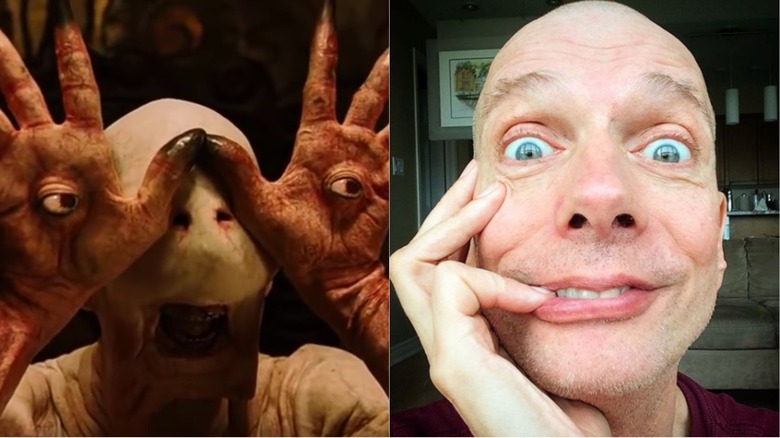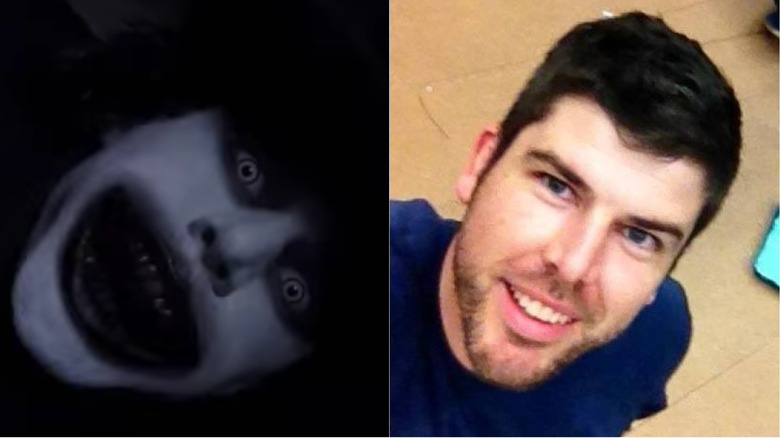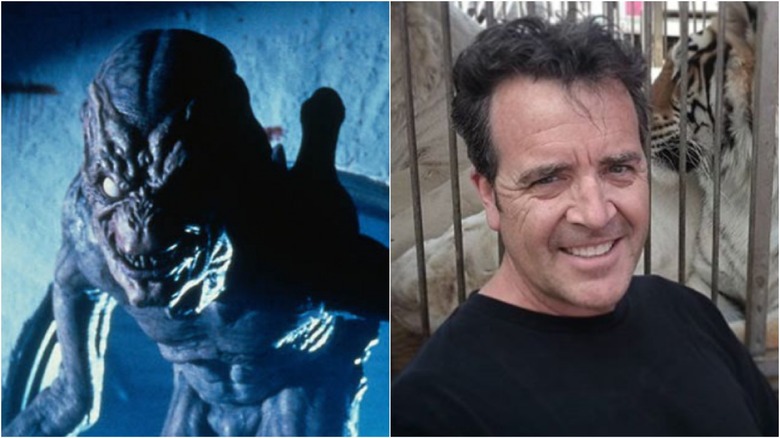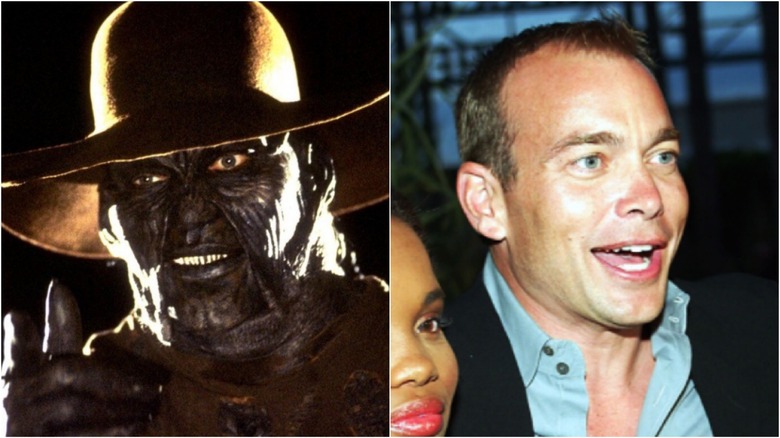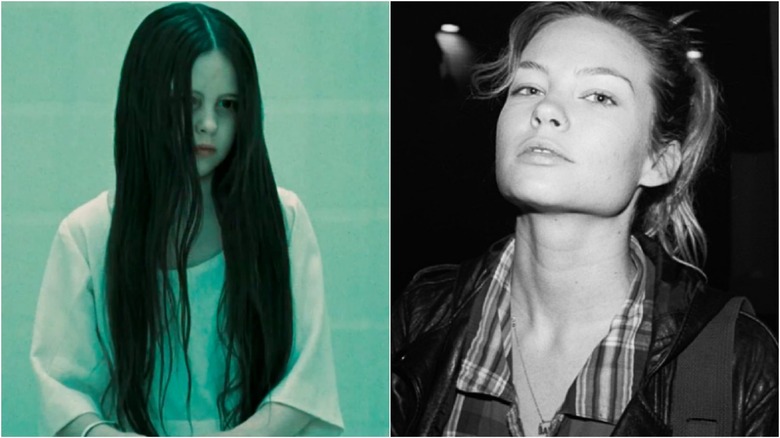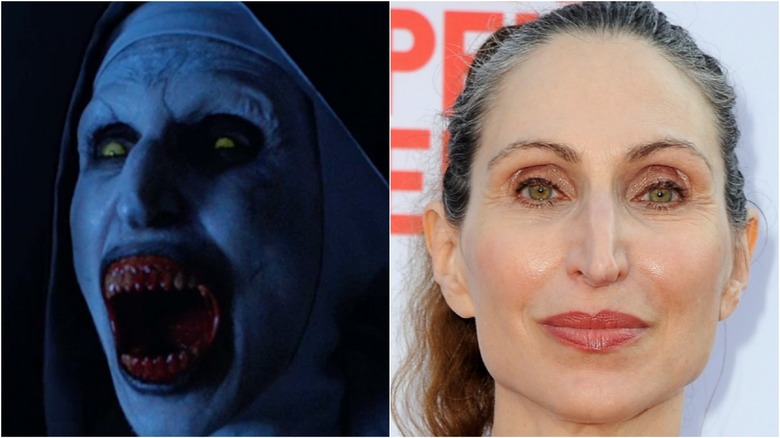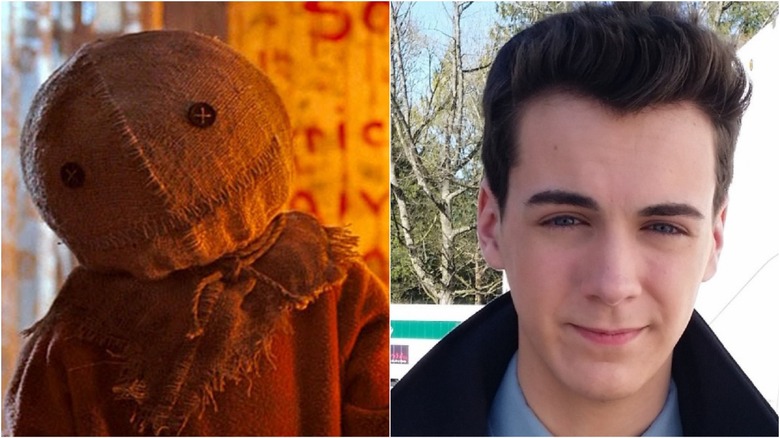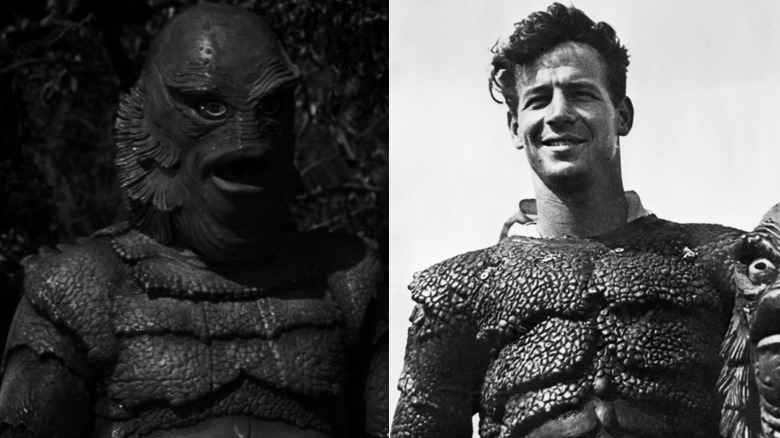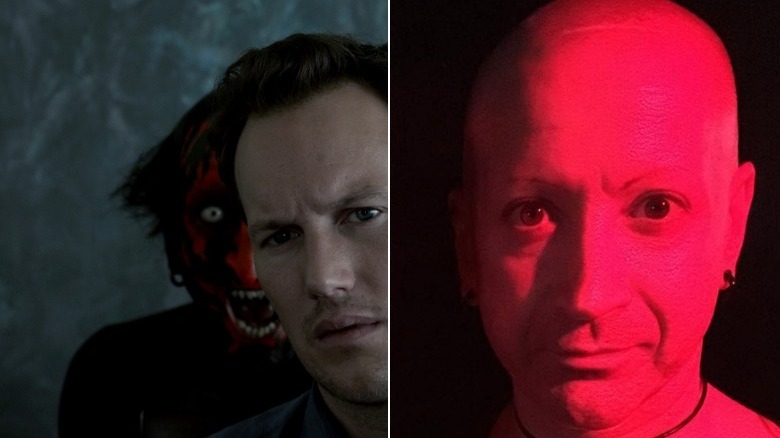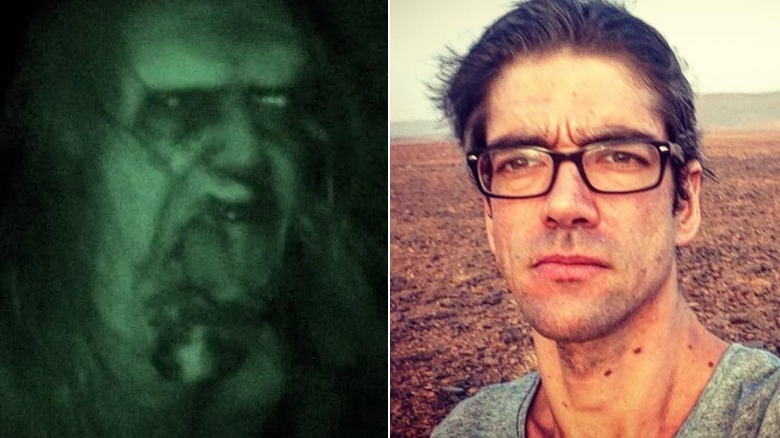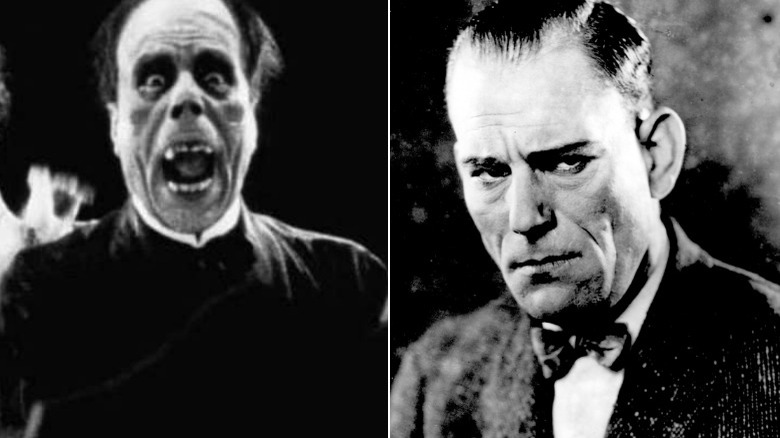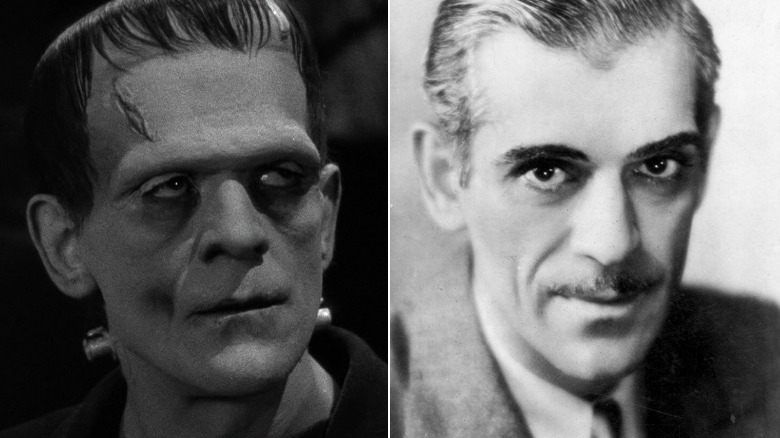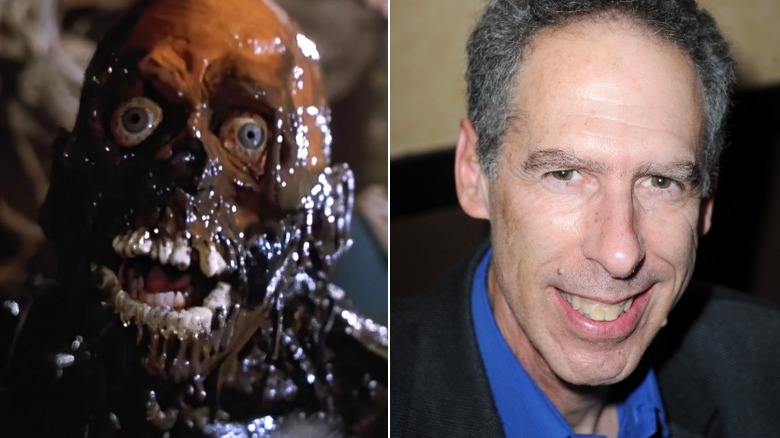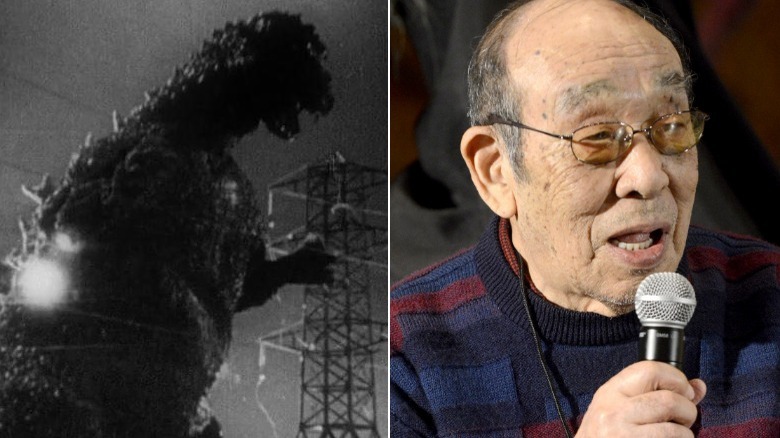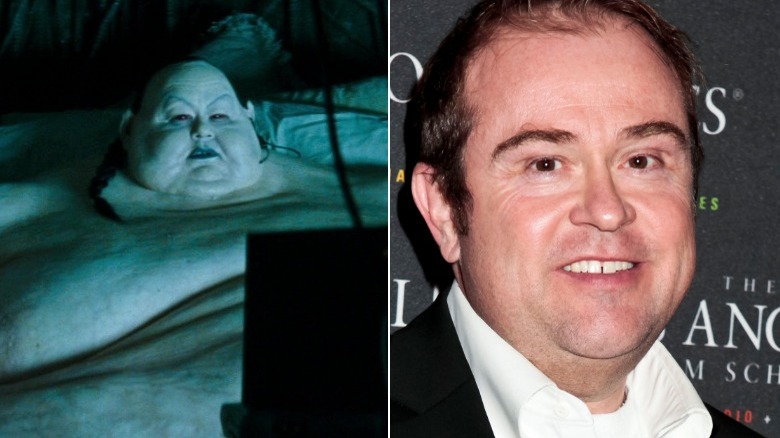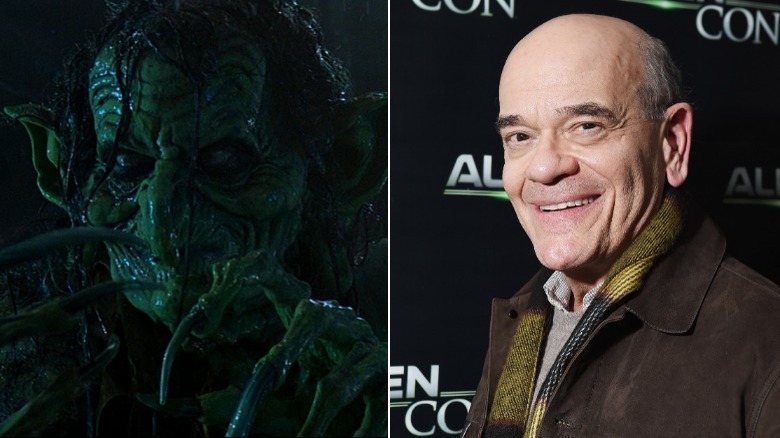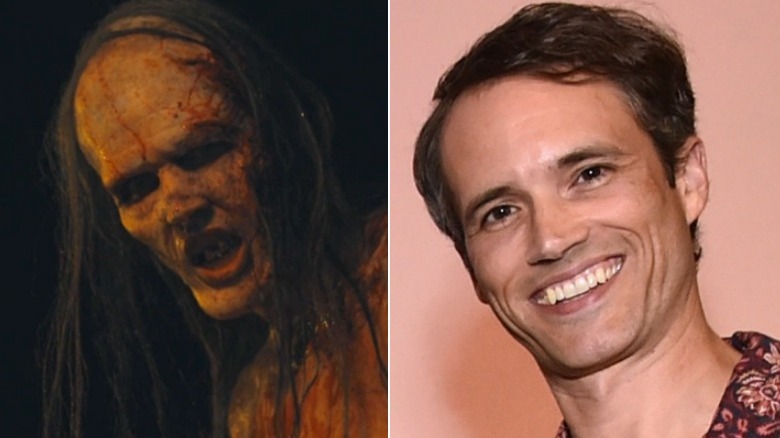What These Horror Movie Monsters Look Like In Real Life
While we might know the story of how young Jason Voorhees drowned in Crystal Lake before rising from the deep to slaughter generations of hormonal teens, or how the Xenomorph slithered off a derelict spacecraft, we don't know much about the actors who played these awesome roles. There's a lot more to being a cinematic monster than waving a prop machete at a fumbling babysitter. It's time we turn off the gore for a little bit and look at the people behind the masks of some of our favorite horror movie monsters.
Pinhead Cenobite played by Doug Bradley
Although writer Clive Barker didn't name the lead Cenobite "Pinhead" in his novel "The Hellbound Heart," the character's distinctive appearance earned the nickname that stuck throughout the "Hellraiser" series. Since "The Hellbound Heart" was adapted into the first "Hellraiser" movie in 1987, English actor Doug Bradley has become synonymous with the soul-harvesting Pinhead.
Bradley is part of a special group of horror actors who have played their haunting characters at least six times in a row, a list that includes Tobin Bell as Jigsaw, Warwick Davis as Leprechaun, Brad Dourif as Chucky, Christopher Lee as Dracula, and Robert Englund as Freddy Krueger—although he's also developed a somewhat complicated relationship with the franchise. Bradley opted not to return for 2011's "Hellraiser: Revelations," and the saga seems to have moved on without him; 2018's "Hellraiser: Judgment" marked the second installment to feature a different actor under the makeup. Still, he'll always be Pinhead to us, and we have to think the majority of franchise fans agree.
Leatherface played by Gunnar Hansen
Tobe Hooper's kooky 1974 horror flick "The Texas Chainsaw Massacre" spawned all kinds of weird and bizarre sequels, but we particularly remember the original thanks to how it stood out compared to other genre entries from the era. Instead of the monster/killer infiltrating houses and chasing people down, the victims were led into Leatherface's lair.
Heavily inspired by the horrific true story of Ed Gein, Leatherface wore a headpiece made of human skin. While plenty of people have picked up the chainsaw since, we'll always remember Gunnar Hansen for his original (and only) portrayal of the role. While other Leatherface actors have come and gone, Hansen set the standard for how to properly play a chainsaw-wielding maniac, utilizing mannerisms that have been repeated in the character's other movie appearances. Fans of the B movie "Mosquito" will also recognize Hansen as one of its main characters—who actually uses a chainsaw to fight off ginormous, blood-sucking bugs.
While he's best known for his horror résumé, Hansen wasn't interested in being a star in that or any other genre; he later quipped that he only got the Leatherface gig because he "filled the door" with his large frame when he showed up to audition, and he turned down a number of later opportunities to play terrifying bad guys, opting instead to focus on his passion for writing. Eventually, Hansen returned to Hollywood, accepting roles in horror outings like "Hellblock 13" and "Next Victim," and enjoying a busy second career that sadly ended in November of 2015, when he succumbed to pancreatic cancer at the age of 68.
The Alien played by Bolaji Badejo
Ridley Scott's "Alien" revolutionized both the science fiction and horror movie genres in 1979. In the beginning, no one knew who was going to be cast as the film's titular monster. Eventually, Ridley Scott was introduced to Bolaji Badejo, a design student from Nigeria. Badejo's thin, lanky frame and near-seven-foot-tall height would help convince viewers that the film's monster couldn't just be some guy in a suit, which many monster movies made obvious over the years.
Badejo only played the alien in the first film of the franchise, but still left a heavy impression, especially since James Cameron's "Aliens" had dozens of Xenomorphs all over the place and future sequels primarily used puppetry and CGI to render their aliens. Badejo's alien is just a bodysuit, but extremely threatening. He ended up doing an amazing job to help sell the illusion, and the Xenomorph would go on to become one of Hollywood's most unforgettable sci-fi monsters. Sadly, Badejo's "Alien" legacy would long outlive him—he was only 39 when he passed away in 1992 after being diagnosed with sickle cell disease.
The Predator played by Kevin Peter Hall
Originally, Jean-Claude Van Damme was cast to play the Predator in the 1987 Arnold flick of the same name. Unfortunately, the bulked-out appearance of star Arnold Schwarzenegger and the rest of the cast made JCVD seem way too small for the role, despite how amazing it would have been if the Predator had kung fu skills. Fortunately, all of that was scrapped in favor of Kevin Peter Hall, who also starred as the towering title character in "Harry and the Hendersons." When you've got guys like Jesse "The Body" Ventura and Apollo Creed himself, Carl Weathers, walking around a jungle, you're going to want to make your movie monster a behemoth, and not just the muscles from Brussels. Thankfully, Hall's tall frame made for a perfect Predator in both the 1987 original and its 1990 sequel, "Predator 2." The year after that film's release, Hall passed away at the tragically young age of 35, his life and career cut short by AIDS-related pneumonia.
Michael Myers played by Nick Castle
John Carpenter's low-budget 1978 slasher classic "Halloween" helped pave the way for bad guys like Jason Voorhees, Freddy Krueger, and Ghostface with the unforgettable appearance of the film's lumbering silent psychotic villain— and future franchise star — Michael Myers. Carpenter added a heavy psychological aspect to the killer that we hadn't seen since Norman Bates decades prior, and envisioned the film's location, fictional Haddonfield, Illinois, as a typically idyllic suburb that turned unspeakably creepy after the sun set on October 31.
After donning the mask in the first movie, Castle would be imitated for years by countless horror villains, including some of the actors on this very list. He went on to enjoy a varied career, too — he co-wrote Carpenter's dystopian action flick "Escape from New York," helped write the story for Steven Spielberg's "Hook," and has directed an assortment of movies that includes "The Last Starfighter" and "The Boy Who Could Fly." And 40 years after making horror history, Castle came full circle, agreeing to reprise his role as Michael Myers in the 2018 "Halloween" sequel.
Pennywise played by Tim Curry
No offense to any of our white and red paint-wearing readers, but clowns creep us out. It's a common fear, and for a generation of horror film fans, a lot of that can likely be attributed to the 1990 made-for-TV miniseries "It."
Based on Stephen King's bestselling horror novel of the same name, "It" tells the story of Derry, Maine, and its ongoing haunting by a supernatural being that manifests itself as its prey's worst fears. Pennywise the Dancing Clown, played by Tim Curry, is a favored form taken by this nefarious being (its real form is later revealed as an otherworldly spider). By this point in his career, Curry was known for playing the Lord of Darkness in "Legend" and Dr. Frank-N-Furter in "The Rocky Horror Picture Show." While ABC's TV restrictions, overall bad acting, and skipping the book's best parts resulted in "It" being a clunker, Curry's captivating performance was the miniseries' saving grace. Bill Skarsgård was definitely horrifying in his own right in the 2017 big-screen adaptation of "It," but we're paying tribute to the original here.
Jason Voorhees played by Kane Hodder
We know, we know: lots of people have played Jason Voorhees. He wasn't even the main killer in the first "Friday the 13th" movie, and he didn't start wearing his iconic hockey mask until the third film, so we've seen the character go through some dramatic changes over the years. 10 actors have played the character so far, in fact, but we're going to have to choose Kane Hodder as the definitive Jason.
While he didn't even sign onto the series until "Friday the 13th Part VII: The New Blood," Hodder's role helped bring Jason into a new age of slasher flicks and made him the hulking, unstoppable menace that we all love and remember. Furthermore, he's had the most experience playing Jason, as nearly every movie prior to "Part VII" had a different actor in the part. Donning the mask for four films ("Part VII: The New Blood," "Part VIII: Jason Takes Manhattan," "Jason Goes to Hell: The Final Friday," and "Jason X"), Hodder remains a horror movie heavyweight champion in our books.
In fact, Hodder's left an impact far beyond the "Friday the 13th" movies. He played Leatherface once (kinda, as a stuntman and stunt coordinator for "Leatherface: The Texas Chainsaw Massacre III"), played Michael Myers (in a parody video showing the durable psycho learning how to drive), and even inspired his own documentary, "To Hell and Back: The Kane Hodder Story," which he used as a forum for sharing his painful past with childhood bullying. And he isn't done with Jason yet: Hodder did motion capture work for "Friday the 13th: The Game," offering fans a chance to be part of the action for a whole new series of slasher thrills.
Freddy Krueger played by Robert Englund
We just had to include the man of your dreams on this list! As much as we liked Jackie Earle Haley in that "Nightmare on Elm Street" remake, only one actor's name resonates with horror movie nightmares: Robert Englund. Horror fans got to watch Englund wear the glove for nearly two decades, playing Freddy Krueger in eight films and even in the character's own anthology horror series, "Freddy's Nightmares." Sure, Freddy got a lot funnier and sillier as the years went by, but "Wes Craven's New Nightmare" was a proper return to form for the supernatural slasher. We just hope one day Englund dons the fedora, sweater, and bladed glove one last time for a final trip down Elm Street.
Pennywise (2017) played by Bill Skarsgard
Taking up the role of an already iconic horror movie monster can be a daunting task, one that even the best actors aren't always up to. Given how excellent Tim Curry is in the 1990 TV movie original, whoever stepped in as Pennywise for the big-screen 2017 version of "It" was going to have some even larger than usual big red clown shoes to fill. Thankfully, Bill Skarsgård was up to the task. His performance differs greatly from Curry's — smart, since it's probably best to make something your own rather than imitate the original. He's uniquely terrifying as Pennywise, more overtly sinister and inhuman than Curry's frightening but undeniably carnival barker-esque turn.
Skarsgård comes from a family of Swedish actors (his father Stellan and brother Alexander are also well known). After appearing in a number of Swedish films, he found his break into the American market as Roman Godfrey on the Netflix original program "Hemlock Grove" for three seasons. Since the show wrapped in 2015, he's also made appearances in "Divergent: Allegiant," "Atomic Blonde," and "Assassination Nation." He also returned for "It: Chapter Two" and starred in the Stephen King-inspired Hulu original series "Castle Rock."
The Pale Man played by Doug Jones
A number of tremendously frightening, unique monsters appear in Guillermo del Toro's masterpiece "Pan's Labyrinth," but they all (pardon the pun) pale in comparison to the Pale Man, who stands as the film's most memorable image, his spindly limbs and eyes embedded into the palms of his hands making for a truly striking, haunting visage. The man underneath the makeup, as it turns out, is someone moviegoers are likely very familiar with — even if they don't realize it.
The days of career creature actors seem to have passed with Lon Chaney Jr., Boris Karloff, and Bela Lugosi. However, nobody seems to have informed Doug Jones. He's the most prominent creature actor in Hollywood, having donned heavy prosthetics to portray a vast array of monsters, mutants, and everything in between. He's a frequent collaborator of del Toro, even sometimes playing multiple roles (he's also the Faun in "Pan's Labyrinth"). He's also made appearances in "John Dies at the End," "Hocus Pocus," and "Ouija: Origin of Evil," and scored a regular TV role as Lieutenant Saru on "Star Trek: Discovery." Nobody brings aliens, ghouls, and mythic creatures to life quite like Jones. It's always a pleasure to see him pop up in a movie — even if we don't recognize him in the moment.
The Babadook played by Tim Purcell
Despite only appearing clearly in the film for a fraction of its runtime, the titular malevolent spirit is the most haunting image in the acclaimed 2014 horror film "The Babadook." With his sickly pale skin, stained teeth, and unsettling outfit, it's no surprise the character has become a modern horror icon. It lends to the character's credibility as a horrifying menace that the man under the Babadook makeup isn't one viewers are likely to recognize.
The film was produced on a very low budget of just $2 million. As such, no big-name actor was hired to play the creature. Instead Tim Purcell, an art department assistant and prop maker on the film, donned the makeup and costume for the role. Purcell has not been credited as an actor since, with "The Babadook" apparently the only film he's worked on at all. While it'd be great to see him bring the menace he instills in the character to other roles, there's definitely a certain merit in taking on one perfect role and then riding off into the sunset.
Pumpkinhead played by Tom Woodruff, Jr.
He might not rank as an elite movie monster like Freddy and Jason, but the titular creature from "Pumpkinhead" isn't anything to scoff at in terms of scare factor. The brainchild of special effects artist Stan Winston, Pumpkinhead, a demonic corpse animated by witches, starred in Winston's original film as well as a series of sequels and comic books. Resembling a sort of cross between the Xenomorph and a goblin, he's a uniquely terrifying creature performed exceptionally by Tom Woodruff, Jr. It makes sense that Woodruff excels in the role, too. Acting under all of those prosthetics requires a deep understanding of how they work, and Woodruff certainly knows that, given his stellar résumé as an effects artist.
While he's appeared in a number of television shows, short films, and full-length movies (often under prosthetics in an unnamed/uncredited role), Woodruff's real claim to fame comes in his work in special effects. Having studied under Winston, he founded Amalgamated Dynamics with his peer Alec Ginnis. Amalgamated Dynamics has gone on to provide effects for everything from later installments in the Alien franchise to tentpole superhero movies, including Sam Raimi's "Spider-Man" trilogy and "X-Men: First Class."
The Creeper played by Jonathan Breck
"Jeepers Creepers" introduced horror fans to The Creeper, a horror movie monster with a unique story: every 23 years it wakes from hibernation for exactly 23 days. During those 23 days it eats human body parts. The parts it eats go on to form its body. Who's hungry? As frightening as that premise is, it'd be worth nothing if not performed by a talented actor. Fortunately, the Creeper has Jonathan Breck in its corner.
Breck appears as the Creeper in all three "Jeepers Creepers" films. It's by far his most famous role, as he's not done much recognizable work outside the franchise. He's appeared in films ranging from "Spy Kids 4: All the Time in the World to Parkland," though never in a role as prominent as the one he plays in the "Jeepers Creepers" franchise, which reached its third installment in 2018; director Victor Salva already has plans for the fourth. Breck may not be a household name, but we'll always be happy — well, terrified might be a more appropriate word — to see him suit up as the Creeper.
Samara played by Daveigh Chase
You might not recognize Daveigh Chase if you saw her in your local coffee shop, but you almost certainly know her voice. As a child actress, Chase provided voiceover work as Lilo in the Disney animated film "Lilo & Stitch," as well as its sequels and TV series. She also provided the English voice acting for main character Chihiro in Hiyao Miyazaki's masterpiece "Spirited Away." While she may be best known for her work in animation, Chase had one other prominent role in the early aughts — though you still likely wouldn't know her face, because she played Samara in the 2002 horror hit "The Ring."
Chase hadn't even turned 13 when she took on the role as the terrifying vengeful spirit who antagonizes the characters in director Gore Verbinski's remake of the Japanese horror classic "Ringu." Nevertheless, she performs the role like a seasoned pro, bringing a sinister supernatural presence to Samara. Chase didn't return for the film's sequels, "Ring 2" and "Rings," but she soon returned to screens in a regular role on the long-running HBO show "Big Love." Since that wrapped, she's appeared steadily in indie horrors and thrillers. It's been 15 years since her turn as Samara, so a return is nigh impossible, but we'll always be curious to see Chase's latest work.
The Nun played by Bonnie Aarons
Director James Wan's "The Conjuring" has gone on to spawn an entire cinematic universe full of uniquely frightening villains. For our money, the scariest character in the franchise is the Nun, also known as the demon Valak. Between its horrific visage and frightening connection to series protagonist Lorraine Warren, Valak is a perfect modern horror monster. As much as the concept alone can sell this one (a demon nun is going to be pretty horrific by default) we'd be remiss to not give credit to the incredible character actress behind the role, Bonnie Aarons.
Aarons has, over the course of her career, had a habit of showing up for bit parts in movies and stealing the show. Her range is just as impressive. She's funny in "The Princess Diaries" and its sequel as a snooty baroness, and terrifying in her brief appearance in David Lynch's surreal "Mulholland Drive." A role like Valak is perfectly suited to her talents, and she made enough of an impression in the role in "The Conjuring 2" to warrant a sequel centered around the character. "The Nun" saw Aarons return to her role as Valak as well.
Sam played by Quinn Lord
"Trick 'r Treat" proves that good things come in small packages. While the film is full of killer performances, it's the little trick-or-treater Sam, played by Quinn Lord, that proves most memorable. Clad in an orange onesie and a mask that seems to be made of a burlap sack, Sam appears throughout the film as a sort of background character, with a subtle, inexplicable menace to his every move. By the end of the film it becomes clear that Sam is no ordinary trick-or-treater, and that he's tied far more directly to the spirit of Halloween than anyone could have guessed.
It'd be selling Lord short to say that his work as a horror movie monster was done for him by Sam's costume. His body language is very deliberate, lending to Sam's mystique and menace in a big way. Lord had been acting for a few years before landing the role of Sam, appearing on shows like "Supernatural" and "Smallville." But "Trick 'r Treat" ended up being his most high-profile role; he's since appeared in guest roles on a number of TV shows, and worked on short films and features as well. As an adult, Lord has appeared in the recurring role of Thomas Smith on Amazon's "The Man in the High Castle." While he's far too old now to play Sam in the "Trick 'r Treat" sequel in development, we can't wait to see where this talented young actor shows up next.
Gill-man played by Ricou Browning
Despite being the Universal Monster with the least amount of credits to his name, Gill-man is one of the cinema's most compelling monster designs. Debuting in Jack Arnold's "Creature from the Black Lagoon," Gill-man's design was, until recently, unsung handiwork by Disney animator Milicent Patrick. Director Guillermo del Toro, who later paid homage to the 1954 classic with his award-winning horror romance "The Shape of Water," described Patrick's work as "the apex of a man-in-a-suit design." We agree: Gill-Man is the perfect balance of pathos and practicality. Wordlessly, it fell to the men behind the airtight molded sponge rubber to humanize the creature's dexterous webbed hands, powerful legs, and accusatory gaze. While Ben Chapman, who portrayed the Gill-Man above water, certainly deserves recognition, it's the other man behind the suit who has inextricably linked himself with the Creature: Ricou Browning.
At 23, Browning worked at Weeki-Wachee Springs, a freshwater roadside tourist attraction. Some out-of-town Hollywood types asked him to help with location scouting. The next thing he knew, they asked him to portray the titular creature in the film's underwater scenes. While Browning ultimately pivoted to working behind the camera — as a writer, director, and stunt coordinator — he reprised his role as the (underwater) Gill-man for two subsequent sequels. Browning and Chapman weren't credited when the film premiered to preserve the creature's mystique. Since then, the horror community has celebrated his work.
The Lipstick-Face Demon played by Joseph Bishara
If you've seen a film by director James Wan, you've probably spied composer Joseph Bishara's name amongst the credits. His scores appear in "Insidious," "The Conjuring," "Insidious: Chapter 2," "The Conjuring 2," "Aquaman," and "Malignant." He also provided musical stylings for non-Wan-directed films in The Conjuring universe — from "Annabelle" to "The Curse of La Llorona." But look closely, and you'll notice that Bishara enjoys more than just a composer credit in a slew of these films.
Yes, the demonic beasties in Wan's films and the larger Conjuring universe are portrayed by the same guy who wrote their killer soundtracks. You can spy Bishara in the quick glimpses of the witch Bathsheba in "The Conjuring" and as Malthus, the demonic entity possessing the titular doll in the "Annabelle" films. However, Bishara's portrayal of the Lipstick-Face Demon in the "Insidious" films is his greatest on-screen contribution to horror history. Maybe it's because he looks like Darth Maul's cousin. Or it's his love of ukulele crooner Tiny Tim? But this child-killing demon is undeniably compelling — in no small part due to Bishara's intimidating screen presence. In a fun twist, per a 2011 interview with Fangoria, Wan and "Insidious" screenwriter Leigh Whannell revealed that they hired Bishara as an actor first and a composer second.
Tristana Medeiros played by Javier Botet
Long before we learn about the gangly creature in the penthouse suite, things have already gone from bad to worse in "[REC]." Playing out in real-time, the Spanish-language found-footage horror film sees two journalists unexpectedly quarantined in an apartment while filming local firemen. What was supposed to be a wellness check has spiraled into a nightmare: trapped at ground zero of a violent infection ripping through the building's tenants, transforming them into ravenously homicidal. In the film's final, heart-palpitation-inducing moments, the miraculously still alive Ángela (Manuela Velasco) and her dedicated cameraman Pablo (Pablo Rosso) enter the penthouse to hide. Inside, they discover the disease's source. The penthouse belonged to a Vatican agent tasked with safeguarding Tristana, a Portuguese girl whose demonic possession became, for lack of a better word, contagious.
In her captivity, Tristana has devolved into a flesh-eating, elongated ghoul whose uncanny countenance is barely seen in the darkness — making her all the more terrifying. Spanish actor Javier Botet, whose slender appearance and flexibility are due to a rare genetic disorder called Marfan syndrome, portrayed Tristana. Botet has made a career out of his life-long love of monsters. Some readers will be surprised to learn he is the man behind several modern horror movie monsters. From the gnarled specters in 2013's "Mama" and 2015's "Crimson Peak" to horrifying apparitions in the latest "It" films to his unbelievable performance as The Crooked Man in "The Conjuring 2," Botet's résumé is wildly impressive.
The Phantom played by Lon Chaney Sr.
When Christine (Mary Philbin) unmasks The Phantom (Lon Chaney), we see his "Death's head." He hisses (by way of a title card) "Feast your eyes, glut your soul, on my accursed ugliness!" While there have been many cinematic adaptations of Gaston Leroux's novel, one of the main characteristics of the obsessive Phantom is his facial deformity, which Leroux describes as a mummified skull. But of all the interpretations — from Broadway musicals to "Phantom of the Mall: Eric's Revenge" — it's the Phantom of the 1925 film that haunts our dreams most.
Born on April Fool's Day 1883 to two deaf parents, Chaney developed a reputation for being the "Man of 1,000 Faces." A self-taught makeup artist and a talented thespian, Chaney's screen presence and transformative power reverberate through the decades with undeniable clarity. As "The Babadook" director Jennifer Kent told Mountain Xpress, Chaney's creatures work because "you can see that it's a person's face...but manipulated so that it looks human, but almost not."
This "uncanny valley" effect defines Chaney's Phantom: his cavernous mouth, the pit of a nose, engorged eyes, and sunken cheeks. In the October 1989 edition of American Cinematographer, film historian Scott MacQueen asked Chaney about his creature design. "I'm supposed to have evolved some magic process of malforming my features and limbs," Chaney said. "It's an art, not magic." He contoured his face and cheekbones with makeup, cotton, and collodion. He flattened his ears to his skull. He wore an exaggerated bald cap that elevated his forehead and used wires to manipulate the curvature of his nostrils.
Frankenstein played by Boris Karloff
Arguably one of the most recognizable monsters in Hollywood history, 1931's "Frankenstein" wasn't the first adaptation of Mary Shelley's 1818 novel: That honor falls to Edison Studios' 1910 "kinetogram" — which you should go watch because it's only 16-minutes long. Directed by James Whale, who later directed the equally fantastic sequel "Bride of Frankenstein," the 1931 film follows a hubristic scientist who successfully reanimates a creature made out of human body parts. Rather famously, William Henry Pratt under the stage name Boris Karloff portrayed the monster. He adopted his stage name when he started performing on-stage in Canada in the early 1910s. Karloff ultimately made his way to Hollywood, appearing in silent films where his Anglo-Indian heritage led to his casting in Arab, Indigenous, and Asian roles. Karloff racked up eighty-one credits before being cast in Whale's "Frankenstein."
Jack Pierce conceived the makeup for Frankenstein's monster. Previously, Pierce worked on Universal Pictures' 1930's "Dracula," which presumably secured him the job bringing Shelley's hulking creature to life. Of all the details that make up the monster's final appearance — the rectangular skull, the overhanging brow, the towering height — one of the subtler features was something of a happy accident. As James L. Neibar relays in "The Monster Movies of Universal Studios," Karloff and Pierce achieved the creature's sunken cheeks by removing the actor's dental plate.
Tarman played by Allan Trautman
It's hard to pinpoint the best part of "The Return of the Living Dead," the hilariously bleak 1985 zombie horror film directed by Dan O'Bannon. (Although rotting corpses using police radios to "send more cops" because they have the munchies is a sure-fire crowd pleaser!) The film's opening credits sequence (with an incredible theme song) is nothing to turn your nose up at either. But in a film full of nothing but highlights, one goopy lad steals the show: Tarman. After the character has been contained in a military-grade metal drum, he becomes more tar than man. Tarman stumbles, sloshes, and drips his way from the basement to the ground floor of the medical supply facility. While some close-up scenes used a puppet, the longer shots required an actor.
Namely: prolific performer and puppeteer Allan Trautman, who readers may know best for his work on Jim Henson projects like "Dinosaurs" and "The Muppets." Speaking on the podcast "Monsters, Madness and Magic" Trautman describes the process of exaggerating his movements and "puppeteering the suit with [his] whole body." The end result is a gait that looks as though the Tarman's joints aren't correctly connected — a staggering lurch that gives the impression of a creature who has putrefied to the point of being more liquid than solid.
Trautman is still bringing creatures to life, lending his voice and puppeteering talents to 2016's "The Jungle Book" and 2021's "Muppets Haunted Mansion," among other modern credits. Given that Trautman reprised his role as the goopy ghoul in "Return of the Living Dead Part II," we're going to assume that, like us, the actor has a soft spot for this rotting hunk of reanimated flesh.
Godzilla played by Haruo Nakajima
Long before Godzilla became a digital CGI goliath, actors portrayed the lizard-like monster by stomping around in heavy, sweaty suits. Through forced perspective, human-sized monsters appeared as towering giants, capable of easily smushing cars, buildings, and historical landmarks. Of all the actors tasked with bringing kaiju to life, one name reigns supreme: Haruo Nakajima.
Born in 1929, Nakajima began his film career as a stuntman in samurai movies and war films, including Akira Kurasawa's "Seven Samurai." Nakajima portrayed Godzilla in twelve consecutive film and is one of the most beloved and prolific "suit actors" in kaiju movies. (You can spot Nakajima as Baragon in "Destroy All Monsters" and as the creatures in 1956's "Rodan" and 1961's "Mothra"). In a 2017 video interview with Great Big Story, Nakajima shared that he would observe animals at the zoo on lunch breaks to find inspiration for Godzilla's gait. He also explains that, in the early days, the suit for Godzilla was made out of mixed concrete — since rubber was in short supply in Japan following World War II — making it extremely heavy. Nakajima retired from portraying monsters in suits in 1972 and passed away from pneumonia complications in 2017 at 88. The filmmaking team behind 2019's "Godzilla: King of the Monsters" dedicated the film to his memory.
Pearl played by Eric Edwards
Excuse us for being nostalgic, but we get a little wistful when we think back to the days when "superhero" movies could flirt with the horror genre. Case in point: 1998's "Blade," the first feature film that sees the titular day-walking, katana-wielding vampire (Wesley Snipes) face off against a blood-sucking megalomaniac who aims to unleash the "blood god." In Blade and company's quest to save humanity, the gang tracks a suspicious human familiar to a secret vampire club. There, they meet Pearl, whose delicate name betrays the fact that this vampire is a grotesque heap of flesh.
While Pearl plays a vital part in our heroes' quest to learn what their nefarious opponents are up to (namely, summoning a big evil blood deity), it's hard to not get distracted by the spectacle of Pearl's whole deal. All told, Pearl is a sight to behold — from his ferocious flatulence to his childlike high-pitch voice. The latter aspect is especially disturbing in light of director Stephen Norrington's comments on the DVD's commentary that Pearl's blob-like size is the result of his hunger for infants.
Somewhere deep beneath several inches of foam latex, is actor Eric Edwards, who sells the comedy and tragedy of Pearl's situation. While Pearl took multiple crew members to fully operate, it's Edwards who gets the credit for being entombed in 700 lbs of latex. As Edwards relays in an archived interview with Comic Monsters, it took five hours to get into makeup and another 45 minutes to get into the suit. Born in Kansas, Edwards' other on-screen performances include supporting roles in "The Little Rascals" and "Sgt. Bilko."
Meg Mucklebones played by Robert Picardo
Fantasy and horror are frequent bedfellows. From man-eating wolves in the guise of grandmothers to a pied piper leading a twisting horde of rats, fairy tales contain images that feel at home alongside some of horror's greatest hits. See: Meg Mucklebones (Robert Picardo), a swamp witch encountered by the heroic Jack (Tom Cruise), in Ridley Scott's "Legend." Much like the film's primary antagonist, Darkness (Tim Curry), the special makeup effects in "Legend" fell to Rob Bottin, whose name will ring a number of goo-coated bells for practical-effects-loving horror fans. Bottin's work features most famously in John Carpenter's "The Thing" and Joe Dante's "The Howling."
In the 2007 documentary short "Creature People," Picardo describes how his work with Bottin on "The Howling" led to his future role. He later came calling when "Legend" needed a patient, professional actor who could perform in latex. Bottin "took a shine to me as an actor," Picardo told the AV Club. "Once the long makeup application process was done...he knew that I would deliver." Picardo certainly does — clacking his spider-like fingers expectantly and giggling expressively through all that makeup!
Born in Pennsylvania, readers will recognize Picardo from his numerous credits on the small screen, from "The Wonder Years" to "Stargate" to "Star Trek: Voyager." With around 240 credits to his name (and counting), Picardo is a prolific character actor and a true talent in and out of the makeup chair.
The Mother played by Matthew Patrick Davis
As "Barbarian" Cinematographer Zach Kuperstein stated, "The main references [for the film] were Fincher upstairs, Raimi downstairs." Sure enough, when our heroine Tess (Georgina Campbell) reluctantly enters the labyrinthine basement, she and the audience realize what movie they're watching now. The potentially murderous Keith (an expertly cast Bill Skarsgård) was just a red herring — whose face juices are mushed quite thoroughly into the floor thanks to "The Mother," a large, naked, aggressive woman who lives in the tunnel system below the house.
Matthew Patrick Davis, a 6'8" theater artist, portrays Mothers. Like the film's writer and director, Zach Cregger, Davis has a background in sketch comedy. While Patrick Davis is no stranger to live performance, his on-screen work has been predominantly on TV shows and short films. Per a chat with No Film School, Davis booked the "Barbarian" gig by sending in a self-tape of himself half-naked "baby-birding" a pickle into an imaginary victim's mouth. In the same interview, Davis revealed that the most challenging part of filming was shooting at night because he was "a** out...and it was so cold." In an interview with Dread Central, Davis described his research process for "Barbarian," which included looking up historical accounts of feral children. Like many of the performers on this list, Davis wanted to humanize his character. Inflecting his performance with real-life stories of victimized individuals helped achieve his desired effect.
